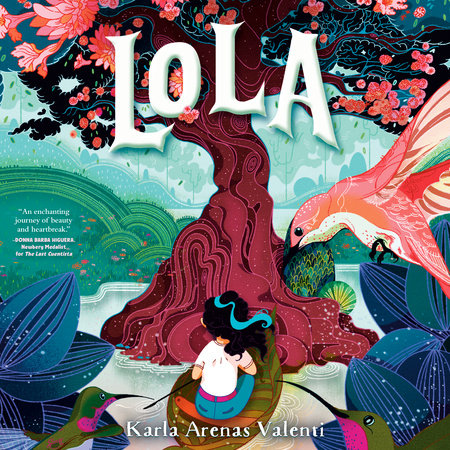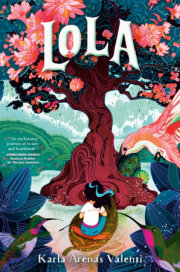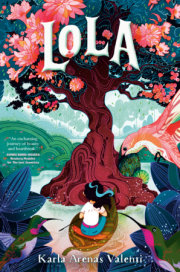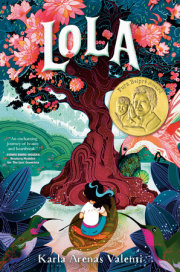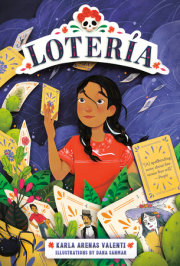1 The first brick was placed the day Lola was born.
It was the cornerstone upon which the entire house was built a decade ago, and given that the house sat on a ravine—always threatening to slip down that ragged slope—it was a pretty important brick. Even so, and despite its rather significant role, the brick was not the most remarkable feature of the house. In fact, aside from a small, enigmatic carving on the side of the brick that read
always and forever, which nobody could explain, the cornerstone was as unremarkable as all the other stones that made up the multilevel home.
By the time Lola, Alex, and her parents moved into the house, this ever-important but unremarkable brick was completely hidden by pink bougainvillea, which, like everything in this house, followed its own set of rules and cared not one bit about what was expected of it. Within days of being planted, the wild tangle of pink flowers had spread across the front of the house, twining through the ironwork of the gates and even creeping into the neighbors’ driveways.
But that wild bush wasn’t the most remarkable feature of Lola’s house, for there was also the ghost. A friendly vanilla-scented specter that had been around since Lola’s big brother, Alex, was a baby. Alex swore the ghost used to play with him as a toddler, knocking over blocks and moving things on the floor so Alex would have to learn to crawl after them. Alex said the ghost was his personal protector, and it even followed the family to their new home after Lola was born.
Then, of course, there were the chaneques: nature spirits that lived in the house, whose job it was to protect all natural elements, including the Tree.
There really was no shortage of unusual aspects to Lola’s house. But in truth, it was the Tree that claimed the grandiose title of
most remarkable feature.
The Tree had been there long before the first brick arrived. Its branches extended far and wide; its roots dug deeper than any pylons supporting the house. And because it had been there first, the house was built around it.
Building a house around a tree takes some planning. For starters, it requires a very high ceiling and a way to get massive amounts of sunshine. So the roof of Lola’s house was built like a triangle. Long, slanted sheets of highly reinforced glass opened up to the sky on the side where the Tree was planted.
Even though the Tree couldn’t talk, Lola was pretty sure it was happy with this arrangement, because the Tree was always in bloom, no matter the weather or season. The summer months brought tiny yellow blossoms that sprouted like popcorn on every branch and filled the house with the scent of mango-guava fruit. Fall was a time of magenta flowers with large velvety petals, each imprinted with a pink starburst. The petals would fall of their own accord and for no apparent reason, but at the most convenient times. Like during a party when the guests were dressed in their finest, and someone needed a touch of color in their hair or on their lapel.
Living on a ravine in Mexico City meant the winter months were chilly. Appropriately, the Tree blanketed itself in what looked like feathery snowflakes. The glittering white flowers wrapped around little fruits that glistened like they held drops of moonlight.
This year, the Tree was late in its winter blossoms. Its branches were still heavy with the magenta blossoms of fall, though they had lost some of their sheen and colorful brightness.
Lola loved the winter flowers and was eager for their return. She was often tempted to pluck one of these fruits and see what they contained. But they appeared otherworldly, almost sacred. No, she would only take what was given, and the Tree did not give up its moonlight fruits. Not until spring, when the scent of snow gave way to the smell of green.
Then the droplike fruits made the Tree glitter brightly in the sunshine that streamed in from overhead. Day after day, the little fruits would gather the light, bloating with all the colors of the spectrum, until they were full to bursting.
And burst they did.
An explosion of rainbow splotches coated every inch of twig, branch, and limb, all the way down to the leathery roots that peeked out from the soil. From these colorful splotches new leaves would sprout, so for the season of spring, the Tree was like an Impressionist painting and a welcome sight after the gray months that preceded it.
And so it went until the weather warmed and the mango-guava blossoms made their appearance once more.
Of course, the Tree couldn’t live off sun alone. It needed water. So the builders had devised an ingenious solution to take advantage of the torrential storms that bathed Mexico City during the rainy season: an indoor waterfall.
The waterfall was an elegant system, with strategically placed tubes that ran under the ground so that when it rained, the water would flow into the tubes and be carried directly to the roots of the Tree.
Lola knew this solution suited the Tree as well, because on particularly stormy nights, when the sky was a battle of light and thunder and the rain pounded against their triangle roof in sheets, the Tree would emit happy bursts of light like the bengalas Lola and Alex lit every Nochebuena.
Lola was especially proud of the fact that even though Alex was four years older, it was she who first dared touch one of the Tree’s sparklers. Lola had expected a shock or perhaps a burning sensation. Alex had been convinced it would electrocute her, and he had stood by with a wooden broom in hand, ready to break her connection to the Tree. What Lola had not expected was for the sparklers to feel like bubbles. And not the tingling of bubbles on her fingertips, but bubbles inside her, as if she’d gulped a full orange Fanta in one swoop. After much cajoling, she convinced Alex to drop the broom handle and join her, then they spent a good half hour giggling uncontrollably.
Now, the final consideration when building a house around a tree is making sure you create a wonderful garden to keep it company.
The Tree’s garden had stalks of golden amaranth, marigolds, and foxglove flowers that were favored by the butterflies that appeared one day and disappeared the next. There were big leafy plants and shrubby plants with white-tipped leaves, plants with long fernlike fronds, and peace lilies with their cupped yellowish-green spathes.
A soft bed of fragrant moss grew at the base of the Tree, and around it was
Tradescantia fluminensis, Lola’s favorite plant of all
. The vinelike
Tradescantia had green leaves striped with lilac, cream, pink, and magenta. But like its pink brethren growing wildly on the outside of the house, the
Tradescantia paid no mind to how it was supposed to function in the world, and one day it simply decided to shift from pink hues to blue hues, sporting a beautiful array of turquoise, indigo, and lapis lazuli stripes. Lola quite liked the change, especially because it matched the unusual streaks of blue that sprouted in her hair at the very same time.
It was this once-pink-but-now-blue
Tradescantia that had Lola’s full attention as she sat at the breakfast table beneath the Tree, for right in the middle of one of its leaves was an odd, misshapen, and crusty spot. It was gray and speckled, like a grain of cement that had splattered onto the plant, and it appeared to be dulling the colors of the leaf all around it.
The grainy stain wasn’t very large and probably not readily noticeable unless you loved this plant and had been watching it grow for as long as you knew it existed.
But once you saw it, it was impossible to ignore.
Lola was not alone in her attentiveness. A group of four concerned chaneques clustered around the plant in worried chatter.
Chaneques were small and stocky, with big round eyes, squat noses, and heavy eyebrows. They had slate-gray hair and gray eyes in various shades from fog to charcoal. They mostly wore gray clothing with a pop of distinctive color. Sometimes they blended into the garden so seamlessly that Lola mistook them for rocks.
But today they were all aflurry and difficult to ignore.
Lola pushed back the tight knot building in her stomach.
Despite its diminutive size, the crusty spot on the
Tradescantia pressed upon her like an evil omen. A heavy sense of dread washed over her.
What on earth is that?
Copyright © 2024 by Karla Arenas Valenti. All rights reserved. No part of this excerpt may be reproduced or reprinted without permission in writing from the publisher.

